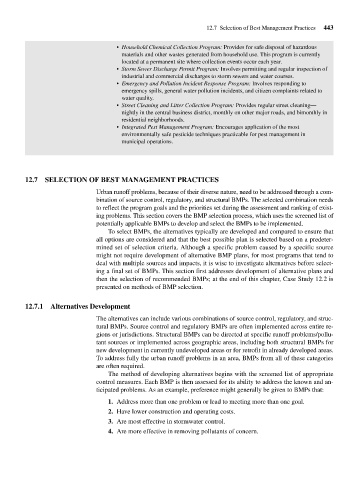Page 485 - Fair, Geyer, and Okun's Water and wastewater engineering : water supply and wastewater removal
P. 485
JWCL344_ch12_398-456.qxd 8/4/10 9:37 PM Page 443
12.7 Selection of Best Management Practices 443
• Household Chemical Collection Program: Provides for safe disposal of hazardous
materials and other wastes generated from household use. This program is currently
located at a permanent site where collection events occur each year.
• Storm Sewer Discharge Permit Program: Involves permitting and regular inspection of
industrial and commercial discharges to storm sewers and water courses.
• Emergency and Pollution Incident Response Program: Involves responding to
emergency spills, general water pollution incidents, and citizen complaints related to
water quality.
• Street Cleaning and Litter Collection Program: Provides regular street cleaning—
nightly in the central business district, monthly on other major roads, and bimonthly in
residential neighborhoods.
• Integrated Pest Management Program: Encourages application of the most
environmentally safe pesticide techniques practicable for pest management in
municipal operations.
12.7 SELECTION OF BEST MANAGEMENT PRACTICES
Urban runoff problems, because of their diverse nature, need to be addressed through a com-
bination of source control, regulatory, and structural BMPs. The selected combination needs
to reflect the program goals and the priorities set during the assessment and ranking of exist-
ing problems. This section covers the BMP selection process, which uses the screened list of
potentially applicable BMPs to develop and select the BMPs to be implemented.
To select BMPs, the alternatives typically are developed and compared to ensure that
all options are considered and that the best possible plan is selected based on a predeter-
mined set of selection criteria. Although a specific problem caused by a specific source
might not require development of alternative BMP plans, for most programs that tend to
deal with multiple sources and impacts, it is wise to investigate alternatives before select-
ing a final set of BMPs. This section first addresses development of alternative plans and
then the selection of recommended BMPs; at the end of this chapter, Case Study 12.2 is
presented on methods of BMP selection.
12.7.1 Alternatives Development
The alternatives can include various combinations of source control, regulatory, and struc-
tural BMPs. Source control and regulatory BMPs are often implemented across entire re-
gions or jurisdictions. Structural BMPs can be directed at specific runoff problems/pollu-
tant sources or implemented across geographic areas, including both structural BMPs for
new development in currently undeveloped areas or for retrofit in already developed areas.
To address fully the urban runoff problems in an area, BMPs from all of these categories
are often required.
The method of developing alternatives begins with the screened list of appropriate
control measures. Each BMP is then assessed for its ability to address the known and an-
ticipated problems. As an example, preference might generally be given to BMPs that:
1. Address more than one problem or lead to meeting more than one goal.
2. Have lower construction and operating costs.
3. Are most effective in stormwater control.
4. Are more effective in removing pollutants of concern.

